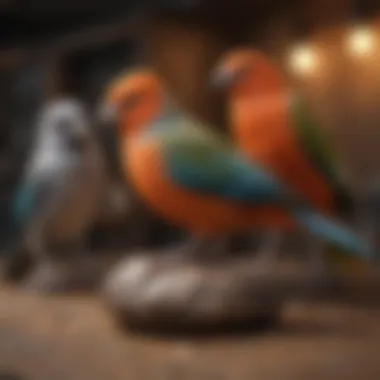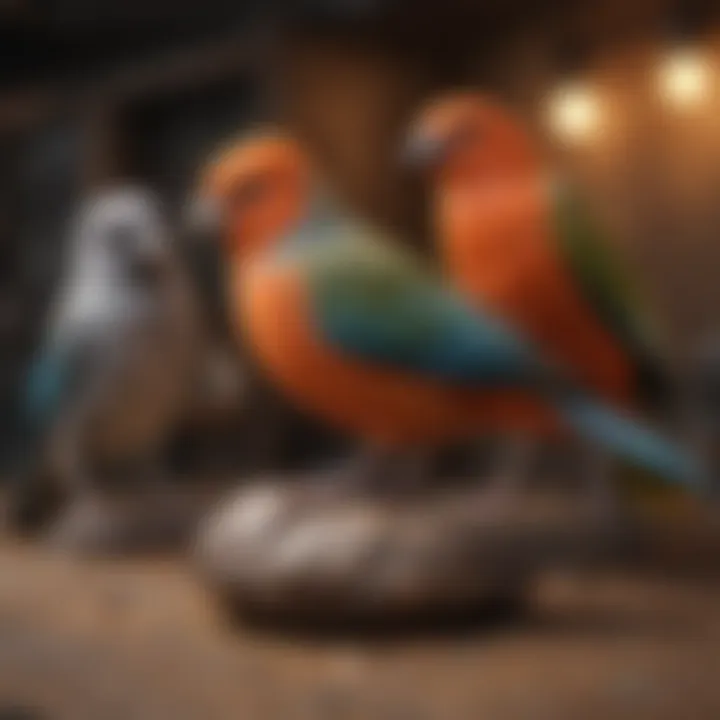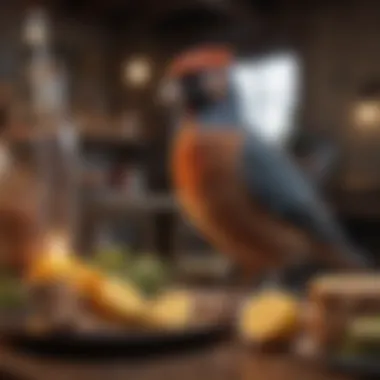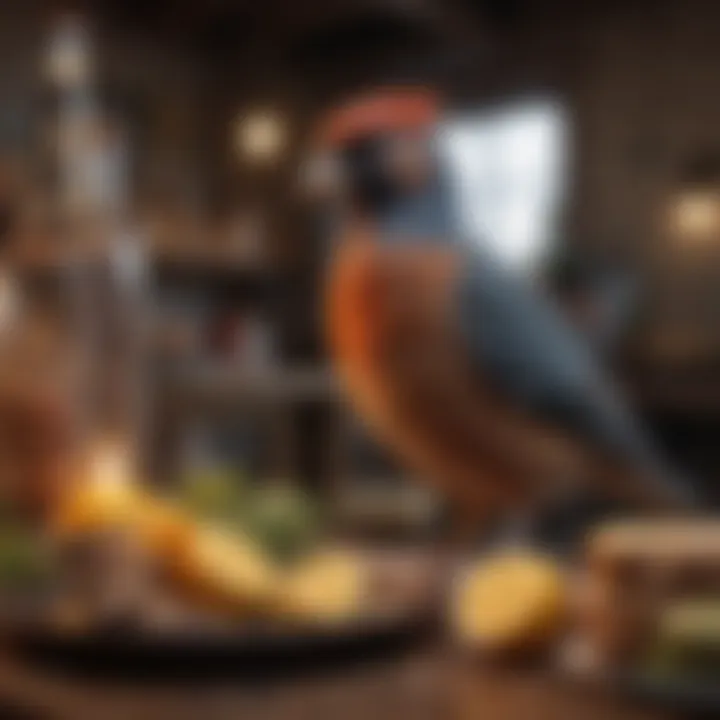A Comprehensive Review of Domestic Bird Species


Intro
Understanding domestic birds goes beyond mere aesthetics or companionship; it's about nurturing lives that depend on us for everything—from food to love. The role of these feathered friends in many homes has been nothing short of transformative. They are not just pets but also invaluable companions, bringing joy and a sense of fulfillment to their owners. This guide serves as an essential resource for pet bird owners, aspiring bird parents, and breeders, diving deeply into various aspects of avian care that promote a healthy and happy life.
Care Tips
Daily Care Routines
Caring for domestic birds is akin to having a living art piece that requires daily attention. Establishing a structured routine is crucial for both the physical and emotional welfare of your feathered companion. This can start with simple tasks such as:
- Morning Feedings: Birds are like clockwork, often getting hungry at daybreak. Fresh food should be offered daily, ensuring they receive a balanced diet.
- Social Interaction: Bonding moments can include talking softly, playing, or letting them perch on your shoulder.
- Evening Routine: Ensure that they settle down as the day ends. Lowering the lights can mimic their natural dusk environment, making them feel secure.
Cage Setup and Maintenance
Creating a suitable environment is not just about aesthetics. It involves understanding what birds need to thrive. The cage should be spacious enough for them to move around freely and should incorporate:
- Perches: Various shapes and sizes encourage movement and foot health.
- Toys: Engage their minds through chew toys, swings, and puzzles that can prevent boredom.
- Cleanliness: Regular cleaning minimizes disease risks. Daily spot cleaning and thorough weekly clean-ups should be the standard.
Hygiene and Cleaning Practices
Hygiene plays a critical role in any bird's health. In addition to cleaning the cage regularly, consider:
- Wash Food and Water Bowls Daily: This prevents bacteria from festering.
- Upper Enclosure Maintenance: Dust and feathers accumulate quickly; cleaning their surroundings keeps air quality good.
- Baths: Many birds love water. Providing a shallow dish for bathing can help in maintaining feather health.
Seasonal Care Adjustments
Birds experience changes in behavior and health needs with the seasons. For example:
- Winter: Keep them away from drafts, provide extra heat if necessary, and consider longer daylight hours with artificial lighting.
- Summer: Ensure that they have plenty of fresh water and avoid placing cages in direct sunlight to prevent overheating.
Behavioral Insights
Understanding Bird Body Language
Birds communicate primarily through body language. Owners should pay close attention to their companion's movements. Some common signs indicate various emotions:
- Fluffed Up Feathers: May signal coldness or distress.
- Tail Fanning: Often a sign of excitement.
- Picking at Wings: Could indicate boredom or stress.
Common Behavioral Issues and Solutions
Misunderstanding a bird's behavior can lead to problems. Common issues include:
- Screaming: This might be a call for attention. Ignoring it can help reduce the behavior.
- Feather Plucking: Often stems from stress; ensuring a calm living environment can help.
Positive Reinforcement Techniques
Birds thrive on positive experiences. Here are strategies to build a strong bond:
- Treat Rewards: Offering their favorite treats for good behavior.
- Praise: Encourage them with soothing tones when they achieve new skills.
Social Interaction Needs
Birds are social creatures. They benefit significantly from interaction with humans and other birds. Consider:
- Encouraging Playdates: If you have multiple birds, ensure they can socialize safely.
- Dedicated Time: Spend quality time daily to strengthen your bond.
Nutrition Guides
Essential Diet Components
Birds require varied foods for optimal health. Their diet should include:
- Fresh Fruits and Vegetables: Ensure these make up a significant portion of their diet.
- Seeds and Pellets: Quality seed mixes and pellets can provide the necessary nutrients.
Safe and Toxic Foods
It's vital to recognize what’s safe and what’s not. Common toxic foods include:
- Avocado: Highly toxic to many birds.
- Caffeine and Alcohol: Even small amounts can be harmful.
Supplements and Treats
Offering treats can improve bonding but should be done wisely. Some safe treat options include:
- Nuts: In moderation, they provide healthy fats.
- Cooked Grains: Brown rice or quinoa can be nutritious.
Feeding Strategies for Different Species
Each species has unique nutritional needs. For example:
- Parakeets: Thrive on a combination of seeds, fresh greens, and occasional fruits.
- Cockatiels: Benefit from a diet rich in fruits, especially citrus.
Wellness and Health
Routine Health Checkups
Regular health check-ups are vital. A visit to an avian vet should occur at least once a year. Early detection of issues can save many headaches down the road.
Identifying Symptoms of Illness
Being observant can save your bird’s life. Watch for:
- Changes in Appetite: Not eating or drinking can signal serious health issues.
- Lethargy: Unusual weakness might needs attention.
Preventative Care and Vaccinations
Keeping your bird healthy often requires preventive measures:
- Vaccinations: Discuss available vaccines with your veterinarian.
- Vitamin Supplements: As needed, particularly in winter months when fresh produce is less available.
Mental and Emotional Well-being
Lastly, birds also need mental stimulation. Enriching their environment can keep them happy and engaged. Consider adding:
- Interactive Toys: Rotating toys can prevent boredom.
- Music or TV: Exposure to sounds and visuals can entertain them.
Enriching Activities


Toys and Playtime Ideas
Toys crafted for birds provide both fun and exercise. Choices should include:
- Chew Toys: To help maintain beak health.
- Puzzle Feeders: These stimulate their cognitive abilities and reduce boredom.
Training and Tricks
Training is a rewarding process for both bird and owner. Techniques might include:
- Step-Up Commands: Teaching them to step onto your finger.
- Simple Tricks: Like turning in circles or waving.
Outdoor Activities and Interaction
Birds enjoy fresh air and new environments. When it's safe:
- Supervised Outdoor Time: Using a harness or in a safe enclosure can provide mental stimulation.
DIY Projects for Mental Stimulation
Engage your bird’s mind with DIY projects:
- Homemade Toys: Simple constructs from paper or safe wood can be entertaining.
- Puzzle Games: Creating scavenger hunts with treats encourages natural behaviors.
“Investing time in understanding and caring for your bird can lead to a rewarding bond that enriches both of your lives.”
As you journey through the world of domestic birds, remember that knowledge is key. Each bird species is unique, requiring tailored approaches to nurture their needs, promote their health, and foster strong relationships.
Foreword to Domestic Birds
Domestic birds hold a unique place in the lives of many around the world, serving as both companions and fascinating creatures of nature. The introduction of this article aims to shed light on the multifaceted nature of these avian friends, exploring essential elements such as species diversity, behavioral traits, and care practices. A keen understanding of domestic birds not only enriches the experience of bird owners but also fosters responsible stewardship in their care.
Understanding domestic birds encompasses more than just their appearance or the joy they bring into our homes. It involves an appreciation of their evolution, the environmental factors that impact their living conditions, and the fundamental aspects of their physical and emotional well-being. This exploration lays the groundwork for comprehending what it means to be a responsible bird owner, allowing bird enthusiasts to make informed decisions.
The journey into this world offers numerous benefits:
- Enriched Relationships: Building a bond with a pet bird can enhance understanding and communication between species.
- Informed Care: Knowledge of dietary needs, health considerations, and suitable environments leads to happier, healthier birds.
- Conservation Awareness: By understanding domestic birds, pet owners can also gain insights into the challenges faced by their wild counterparts, promoting advocacy for conservation efforts.
As we delve deeper into the intricacies of domestic birds, we will define what sets them apart, trace their paths of domestication, and illuminate how their needs can be thoughtfully met within our homes.
Defining Domestic Birds
In simple terms, domestic birds refer to species that have evolved alongside humans, adapting to life in captivity. These avian companions range from the commonly known parakeets, finches, and canaries to the less familiar, such as the African Grey or the Gouldian Finch.
When we talk about domestic birds, we are usually referring to those that have been bred for specific characteristics that make them suitable for life with people. Some of these traits include:
- Amiable Temperament: Many domestic birds are friendly and capable of forming bonds with humans.
- Controlled Breeding: Selective breeding has resulted in various colors, sizes, and patterns that appeal to avian enthusiasts.
- Manageable Care Requirements: These birds are often easier to care for and maintain in a domestic setting compared to their wild counterparts.
Understanding what qualifies as a domestic bird sets the stage for deeper conversations about their behavior, needs, and how to best support them in our homes.
The Evolution of Domestication
The domestic birds we see today are the end products of thousands of years of evolution and selective breeding. The journey of domestication began when various species were first drawn to humans, initially for food or other resources. As time went on, human efforts to tame these creatures led to significant changes in their behavior and breeding.
Each species has its unique story. For instance, domestic chickens, derived from the Red Junglefowl, are a direct result of interactions between humans and wild birds for meat and eggs. This is quite different from the evolution of budgerigars, which have transformed from wild associations into popular pets due to their colorful plumage and friendly nature.
Understanding the history of domestication can provide invaluable insights:
- Behavioral Instincts: Many staple traits seen in today’s domestic birds—like social behavior—stem from their wild origins.
- Genetic Diversity: Recognizing how birds were bred informs us about their health and longevity.
This evolution emphasizes the importance of adapting care approaches based upon their past and the expectations of modern pet owners.
Key Species of Domestic Birds
The topic of key species of domestic birds is pivotal in understanding the diverse world of avian companions. These species not only bring joy to homes but also play significant roles in various cultures and ecosystems. Recognizing different types allows potential pet owners and bird enthusiasts to make informed decisions, focusing on compatibility and care needs. By delving into these species, one gains insight into their unique behaviors, dietary requirements, and health considerations, ultimately leading to a fulfilling experience in aviculture.
Common Pet Birds
Common pet birds have found their way into households across the globe, enriching lives with their presence and personality. Species like budgerigars, cockatiels, and lovebirds are often favored for their affable nature and relative ease of care. For instance, the budgerigar, with its chatty demeanor and vibrant colors, is not just visually appealing; it has the smarts to learn tricks and mimic sounds. Their playful antics can provide endless entertainment.
Cockatiels, on the other hand, are known for their gentle disposition. Their distinctive crest and ability to whistle tunes make them a favorite among families. With proper socialization, they can become affectionate companions, actively engaging with their owners. Lovebirds are another popular choice, known for being social pairs. They thrive on interaction and tend to bond closely with their human caregivers. Their charming behaviors showcase their exuberant personalities, though it’s essential to note they flourish in pairs to maintain emotional health.
- Small-sized birds often require less space and can adapt to apartment living easily.
- Interactive behaviors make them engaging pets, promoting daily companionship.
- Easier maintenance often comes with common birds, as they typically have well-documented care requirements.
Before bringing any pet bird home, potential owners should seriously consider the dedication involved in their care. Even smaller species can have big personalities and varied demands.
Rare and Exotic Species
Venturing into the realm of rare and exotic species presents both thrilling opportunities and unique challenges for bird enthusiasts. Species such as the African Grey Parrot and the Macaw offer a glimpse into the vast diversity of avian life. For example, the African Grey is often lauded for its incredible intelligence and remarkable vocal abilities. They form strong bonds with their owners; however, this also means they require significant mental stimulation and social interaction. Neglect in these areas could lead to behavioral issues like feather plucking or excessive vocalization.
Macaws, characterized by their stunning plumage and sociable nature, can be an eye-catching addition. Their playful and affectionate disposition often captures the hearts of those who encounter them. But their exuberance necessitates ample space and dedicated time for play, ensuring consistent mental engagement and physical exercise.
- Diverse habitats: Rare species may have specific habitat requirements, making it crucial for owners to replicate conditions similar to their natural environment.
- Higher care requirements: Many exotic birds come with complex dietary needs and veterinary care considerations, which could prove demanding.
- Conservation matters: Often, these birds are threatened in the wild. Therefore, ownership should be accompanied by an awareness of ethical considerations, promoting conservation efforts.
"Caring for exotic species is not just about love; it’s a commitment to understanding and respecting their natural history."
Ultimately, having rare and exotic species demands profound dedication and knowledge, making them suited for informed and committed bird enthusiasts. Each bird, whether common or exotic, deserves the proper environment and care to flourish. Engaging with key species not only enhances one’s understanding but also enriches the relationship between humans and their feathered companions.
Physical Characteristics
Understanding the physical characteristics of domestic birds is essential, not just for identification, but also for realizing their health needs and behaviors. The way a bird looks tells a story about its species, genetics, and even its environment. Knowledge in this area enriches a pet owner's ability to provide appropriate care, identify potential health issues, and appreciate the diversity and beauty among different species.
Size Variations
Size variations among domestic birds range from the petite budgerigar to the relatively grand macaw. This diversity impacts various aspects of care, including housing, diet, and even socialization needs. Smaller birds like finches and canaries often require less space and can thrive in compact environments. On the other hand, larger species like cockatoos need more room to spread their wings and engage in natural behaviors.
It’s worth noting that size isn't just about physical space; it can affect a bird's behavioral dynamics as well. Larger birds tend to exhibit more pronounced social behaviors, often forming tighter bonds with their owners, while smaller birds may display different kinds of social interactions that are equally rich albeit more subdued.
Feather Patterns and Colors
When it comes to feather patterns and colors, the aesthetic appeal is undeniable. Colors can signal many things—from the bird's mood to its health. For instance, vibrant and well-maintained feathers often point to a healthy diet and happy environment. Some birds, like the lovebird, come in a rainbow of hues, each indicating different genetic backgrounds and traits.
Understanding genetics can also help potential owners choose a species that matches their personal preferences. For example, an American parakeet is often seen flaunting bright yellow and green feathers, while a blue parakeet displays its stunning pigmentations. An owner’s efforts in providing appropriate nutrition can directly influence feather quality, which in turn affects the bird's self-esteem and overall demeanor.
Unique Anatomical Features
Unique anatomical features can be strikingly different among bird species. For example, some birds have curved beaks designed for cracking seeds, such as finches, while others have long, slender beaks intended for probing flowers, as seen in hummingbirds. These adaptations aren't just fascinating; they highlight how each species has evolved to survive and thrive in its specific niche.
Another interesting feature is the zygodactyl foot structure, commonly found in parrots, which enables them to grasp and manipulate objects effectively. This anatomical trait underscores the importance of mental stimulation and enrichment in their care, allowing them to explore and interact with their environment in meaningful ways.


It's crucial for bird owners to recognize these physical traits, as they can provide invaluable insights into their pets' needs and behaviors.
Behavioral Insights
Understanding the behavior of domestic birds is crucial for their wellbeing and the harmony within their living environments. Birds have complex social structures and a unique way of communicating, much like humans and other animals. Grasping these aspects not only enhances the quality of life for our feathered companions but also strengthens the bond between the bird and the owner.
Social Structures and Hierarchies
Every species has its own social norms, and domestic birds are no exception. In the wild, many birds live in flocks, where hierarchical structures help maintain order and provide safety. For instance, in parakeets, a dominant bird often leads the group and chooses the best feeding spots. In a domestic setup, understanding these dynamics can guide owners in forming a harmonious community among their birds.
- Establishing roles: Birds need to know their place. Mixing species without understanding their social needs can lead to squabbles.
- Encouraging interaction: Allowing birds to socialize helps them develop healthier behaviors. It’s vital for mental health just as much as physical activity.
- Expressing dominance: Often seen through posturing or vocalization, deciphering these signals can reduce conflicts among birds and enhance their overall happiness.
Communication Patterns
Birds communicate through various means – be it vocalizations, gestures or even visual displays. Understanding how they express and receive messages is paramount for prospective bird owners.
- Vocalizations: Different species have distinct calls. Cockatiels might whistle a cheerful tune, while parrots might mimic human speech or other environmental sounds. Each sound usually has a context that can mirror their moods and environments.
- Body language: A bird's posture, feather position, and wing extensions can convey a range of feelings. A bird puffing up its feathers often signifies it feels threatened, whereas a bird that leans forward might be displaying curiosity.
- Interactions with humans: Observing how birds respond to human actions often speaks volumes. If a bird keeps trying to engage with its owner, it is an indication of trust and a desire for connection.
Signs of Stress and Well-Being
Recognizing stress signals in birds is fundamental in providing proper care. Birds cannot communicate distress verbally like other pets, so observant owners must learn to read signs of discomfort or health issues.
- Abnormal behaviors: If a bird suddenly becomes quiet, stops preening, or isolates itself, these may be indications of stress or illness. Such behavioral changes should never be overlooked.
- Feather plucking: This is often a red flag for stress; it not only emphasizes the need for a calm environment but also points towards possible medical concerns.
- Screaming or excessive vocalizations: While birds are communicative, a notable increase in noise can signify anxiety, sometimes linked to boredom or insufficient stimulation.
Recognizing and addressing signs of stress in domestic birds can substantially improve their quality of life, leading to healthier and happier companions.
Ensuring that domestic birds thrive within their chosen environments requires diligence and understanding of their social structures, communication methods, and stress signals. Educated and vigilant owners can foster a loving, nurturing atmosphere where their avian friends feel safe, loved, and understood.
Dietary Requirements
Understanding the dietary requirements of domestic birds is fundamental for their long-term health and well-being. Just like how humans thrive on wholesome food, birds need the right balance of nutrients to maintain their energy levels, promote growth, and facilitate overall development. The content in this section dives into the essential nutrients birds need, what foods should be included in their diet, and common pitfalls that bird owners might fall into. When appropriately addressed, these aspects can help owners foster healthier, happier birds.
Essential Nutrients
Birds, despite being small creatures, have specific dietary needs that are akin to the complex nutritional needs of mammals. They require a mix of proteins, carbohydrates, fats, vitamins, and minerals, each playing a distinct role.
- Proteins are crucial for feather development and muscle maintenance. Sources like legumes, seeds, and specially formulated pellets can serve as good protein bases.
- Carbohydrates provide energy. Fruits and vegetables are not only tasty but also a great source of natural sugars.
- Fats contribute to energy storage. Seeds from sunflowers or safflowers can be included but should be given in moderation because of their high fat content.
- Vitamins—especially A, D, E, and K—support various bodily functions from vision to clotting.
- Minerals like calcium are fundamental for bone health and egg production in females. Grit and cuttlebone are excellent options for supplementation.
Taking a diversified approach ensures that the bird doesn’t end up lacking nutrients, something that's a grave concern for many avian enthusiasts.
Food Sources and Supplements
Feeding domestic birds is not just about tossing seeds into a bowl. It involves curating a balanced diet made up of various food sources. The array of options can be broad, but understanding which foods work best is crucial.
- Pelleted Diets: These often provide a balanced nutritional base. Brands like Higgins and Kaytee offer formulas that cater to different bird species.
- Fresh Vegetables: Leafy greens like kale, spinach, and broccoli are typically well-received. Cut into small pieces to ensure easy consumption!
- Fruits: Apples, grapes, and berries can be great treats. Just be sure to wash and remove any seeds or pits that could be harmful.
- Seeds and Grains: While seeds can deplete essential nutrients if overfed, they can be included as part of a mixed diet. A mix of grains and seeds can provide additional fiber.
- Supplements: Calcium and vitamin supplements are often necessary, especially for breeding birds. Look into products like Avia Charge for a well-rounded approach.
Utilizing a combination of these options promotes variety and prevents boredom, which can be just as damaging as poor nutrition.
Common Dietary Mistakes
Despite the intention of offering proper nutrition, many bird owners stumble upon dietary pitfalls that can lead to health problems down the line. To be mindful of your pet's diet, consider these common mistakes:
- Overreliance on Seeds: Seeds are often favored for their taste, but they lack many vitamins and minerals, leading to malnutrition over time.
- Neglecting Fresh Foods: Skipping out on fresh fruits and veggies deprives birds of essential nutrients and can diminish their zest for life.
- Ignoring Water Quality: Clean and fresh water is vital, and neglecting its quality can lead to health complications. Regularly changing the water bowl is a small effort that can yield large benefits.
- Feeding Unsafe Foods: Certain items like avocado and chocolate are toxic to birds. Be informed and avoid these dangerous pitfalls.
"The right diet for domestic birds is a treasure chest of health—they thrive, but only if you give them a balanced approach!"
Taking the time to understand the dietary requirements, the importance of diverse food sources, and avoiding common mistakes sets the stage for a fulfilling bond between bird owners and their feathered friends. All of this directly contributes to enhanced well-being, and surely every bird deserves that.
Caring for Domestic Birds
Caring for domestic birds holds immense significance in maintaining their health and happiness. These creatures, while often perceived as mere companions, require thoughtful nurturing and attention. The benefits of understanding how to care for them go far beyond providing food and water; they encompass creating an enriching environment and fostering a bond that enhances the overall experience of bird ownership.
Housing and Environment
Creating an apt housing environment is the cornerstone of avian care. Domestic birds thrive in spaces that mirror their natural habitats. Ideally, this means providing a cage or aviary that is spacious enough for them to stretch their wings and explore. Not just any cage will do; the size should cater to the specific species of the bird.
For instance, a cockatiel finds joy in a cage that allows for ample horizontal flight, while a larger parrot demands vertical space. Accessories are equally important; perches, toys, and feeding stations should be strategically placed to encourage climbing and play. Natural materials like untreated wood make excellent perches, promoting foot health.
"A well-kept home is not just a cage; it is a sanctuary for your feathered friend."
Moreover, environmental factors such as light and temperature cannot be overlooked. Birds benefit from sunlight exposure but also need areas to retreat from direct sun. Maintaining a consistent temperature is crucial—extremes can lead to stress or health issues.
Health Monitoring and Veterinary Care
Regular health monitoring is key to ensuring your domestic birds stay in tip-top shape. Birds are adept at hiding illnesses, so being observant is essential. Changes in behavior or eating habits can signal underlying issues. Keep an eye out for signs like fluffed feathers, lethargy, or changes in droppings.
Establishing a relationship with an avian vet is vital. Annual checkups should be part of your routine, focusing on essential aspects like weight checks and beak health. Vaccinations, though often overlooked, can prevent diseases that could be fatal.
Understanding common ailments can also prepare you for any situation. For example, respiratory infections manifest in nasal discharge or unusual sounds during breathing. If you notice these symptoms, swift action is needed.
Safety and Enrichment
Birds are inherently curious creatures, often getting into situations that can lead to harm. Safety measures at home must be reinforced to protect them from potential hazards. Common household items like open windows, toxic plants, or small objects can pose serious threats.
Implementing bird-proofing techniques is wise—window screens, keeping hazardous materials out of reach, and securing heavy items can prevent accidents.
Equally important is enrichment. Boredom can lead to behavioral issues like feather plucking or aggression. Providing a variety of toys, including chewable items and puzzle feeders, stimulates their minds and keeps them engaged. Rotating toys regularly can help sustain their interest and curiosity.
In summary, taking the time to carefully consider their housing, health, and safety can significantly enhance your domestic bird’s life. This dedication not only fosters a happier environment for them but also deepens the relationship you share together.
Understanding Avian Health
Understanding avian health is a cornerstone in maintaining the well-being of domestic birds. Much like any other companion animal, birds can suffer from a range of health issues that, if left unaddressed, can lead to serious consequences. Being aware of common ailments, symptoms, and preventative measures plays a critical role in ensuring not just the longevity of pet birds, but also their quality of life. This section will explore the common diseases that can affect these feathered friends and the essential practices that can mitigate such risks. A proactive approach, rather than a reactive one, can make a significant difference.
Common Ailments and Their Symptoms
Birds, though resilient creatures, can fall prey to various ailments that might go unnoticed until they have progressed. Some common concerns include:
- Respiratory Issues: Signs like coughing, wheezing, or mucus build-up can indicate a respiratory infection or allergy. If you notice your bird is struggling to breathe or has changed its vocalizations, it needs immediate attention.
- Psittacine Beak and Feather Disease (PBFD): This viral infection primarily affects parrots, resulting in feather loss and beak deformity. Symptoms to watch for include a change in feather quality and significant changes in behavior.
- Gastrointestinal Problems: Changes in droppings can often point towards digestive issues. Diarrhoea, excessively dark feces, or any change in usual poop habits should be a red flag.
- Nutritive Deficiencies: Birds not receiving a balanced diet may develop various conditions. For example, a lack of vitamin A can lead to respiratory problems and skin issues.
Regular health check-ups and being vigilant of changes in behavior or physical conditions can help catch these problems early on. Understanding the specific needs of different species can also aid in prompt identification of ailments.
Preventative Healthcare Practices
Prevention is the best medicine, especially when it comes to avian care. A few practices can significantly contribute to the overall health of your feathered companion:
- Balanced Diet: Make sure to provide a varied diet. Seed alone is not enough; include fruits, vegetables, and specific pellets that meet their nutritional needs. This way, you're not only nurturing them but also preventing deficiencies down the line.
- Regular Check-ups: Schedule veterinary visits at least once a year. Avian vets can provide insights tailored to your bird’s species and health history.
- Clean Environment: Keeping their living space clean can prevent diseases. A dirty cage can host harmful bacteria and parasites.
- Monitoring Weight: Weight fluctuations are telltale signs of health issues. Regularly weighing your bird can help you catch any significant changes early.
"An ounce of prevention is worth a pound of cure." - This adage rings especially true in aviculture. With an understanding of the risks and attention to preventative measures, bird owners can ensure their companions lead a healthy and vibrant life.


The bond between a bird and its owner is strengthened through understanding and compassion. By prioritizing their health, we not only improve their lives but also deepen our connection with these fascinating creatures. Always remember that the well-being of your feathered friend is a reflection of the care and effort you invest.
Behavioral Training of Domestic Birds
Behavioral training of domestic birds is not just about teaching them tricks; it is a vital aspect of fostering a harmonious and enriching relationship between the bird and its owner. Understanding the importance of training can lead to improved well-being for the birds, as well as reduced behavioral issues and enhanced bonding experiences.
When you think about it, training a bird is akin to forming a partnership. Just like you would work with a friend to achieve a common goal, training your bird can strengthen your connection while offering a way to communicate more effectively. Birds, with their unique intelligence and social nature, thrive on mental challenges and interactions. Training is not only stimulating for their minds but can also be a preventive measure against boredom-related issues, such as feather plucking or excessive squawking.
Moreover, through consistent training methods, owners can ensure their birds are well-mannered, reducing the likelihood of problematic behaviors that may strain family harmony. It nurtures an environment where birds feel secure, leading to happier and healthier avian companions.
Basic Training Techniques
Basic training techniques for domestic birds are essential tools that every owner should be familiar with. At the core of training is positive reinforcement, a principle that revolves around rewarding desired behaviors to encourage their repetition. Here are some techniques to keep in mind:
- Use of Treats: Birds often respond well to food rewards. Small pieces of their favorite fruits or seeds can act as powerful motivators during training sessions.
- Clicker Training: This method uses a small device that makes a clicking sound to mark the exact moment a bird performs a desired behavior, followed by a reward. This helps birds understand what action they are being rewarded for.
- Short Sessions: Birds have varying attention spans, so it’s best to keep training sessions brief—about 5 to 10 minutes—several times a day helps maintain their interest without overwhelming them.
- Consistency is Key: Using the same commands or signals regularly reinforces understanding. If a bird learns that "step up" means to climb onto your finger, be consistent in using that phrase.
- Patience and Repetition: Birds learn at their own pace, so patience is a must. Repeat commands and actions multiple times to deepen their understanding.
Training should always be fun for both you and your bird. The ideal training environment is calm and free from distractions, allowing the bird to focus on the task at hand.
Addressing Behavioral Issues
Even with the best training methods, issues can still arise. Understanding how to address these behavioral problems is critical for any bird owner. Common concerns include excessive vocalization, biting, or aggression towards other pets.
Here are some strategies to tackle these issues:
- Identify Triggers: Observing and identifying what situations lead to undesirable behaviors can illuminate solutions. For instance, does your bird get agitated when another pet is near? Knowing the trigger allows you to adjust the environment.
- Redirect Behavior: If a bird is honking too loudly, distract it with a toy or an alternative activity. This often shifts their focus and reduces the unwanted behavior.
- Establish Clear Boundaries: It’s essential for birds to understand what behaviors are acceptable. Gently but firmly communicate boundaries; for instance, if biting occurs, calmly remove yourself until the bird calms down.
- Counter-Conditioning: If a bird displays aggressive behavior towards a certain item or person, gradual exposure under controlled conditions—rewarding calm behavior—can shift their perception and reduce aggression over time.
- Seek Professional Help: Sometimes, consulting an avian behaviorist or a veterinarian experienced in avian care can provide additional insights and strategies tailored to your bird’s needs.
Behavioral training is an ongoing journey. The bond you create through consistent training not only helps to curtail negative behaviors but also enriches the lives of both you and your feathered friend.
By incorporating these techniques and addressing behavioral concerns thoughtfully, you'll pave the way for a more harmonious home and a well-adjusted bird.
The Bond Between Birds and Owners
The connection forged between birds and their owners transcends mere companionship. This relationship is pivotal, influencing both the psychological well-being of the bird and the emotional health of the owner. When nurture and care intertwine, an enriching journey unfolds, elevating the quality of life for both parties involved. Let's delve into how this bond can be enhanced and the implications of nurturing avian companions.
Fostering Trust with Avian Companions
Establishing trust is crucial when developing a relationship with a bird. Birds, much like humans, are sensitive beings. They may have had checkered pasts or encounters, so their trust can take time and patience to cultivate. Here are several strategies to help build that essential trust:
- Consistency is Key: Interact with your bird at the same time each day. Predictability creates a sense of security, which in turn nurtures trust.
- Gentle, Calm Handling: When first handling your bird, begin slowly. Avoid sudden movements; birds require a gentle touch to feel safe.
- Positive Reinforcement: Use treats and praise to encourage desired behaviors. It’s akin to offering an olive branch, signaling that good things happen around you.
- Observe Body Language: A bird's posture speaks volumes. Relaxed feathers and a cocked head indicate comfort, while puffed feathers or a turned back may suggest fright or distrust. Drilling down into these clues can ease the path to connection.
- Respect Their Space: Birds need their own solitude. Allowing them time alone can foster confidence, indicating you acknowledge their needs.
Over time, with gentle patience, many birds grow to allow their owners into their world, learning to trust that it’s a safe haven.
Sharing Spaces: Coexistence Tips
Creating a harmonious living environment for both birds and humans requires mindful planning and consideration. Birds are social creatures by nature, and they thrive in environments where they feel secure and included. Here are some effective strategies to ensure a smooth coexistence:
- Safe Zones: Designate safe areas for your bird to explore freely. This offers them a controlled space to discover without the worry of harm. Avoid letting them venture into high places—everything from window sills to ceiling fans can be a danger.
- Routine Interaction: Engage in daily activities together, creating a routine that fosters connection. Birds enjoy being part of daily life; integration into social activities can strengthen bonds.
- Quiet Spaces: Birds can be sensitive to loud noises. Ensuring they have access to a quiet area where they can retreat when the environment becomes too hectic may help minimize stress.
- Toys and Stimulation: Keeping a range of stimulating toys available is vital for both mental health and reducing boredom. Rotate toys regularly to keep the environment fresh and exciting.
- Freedom of Movement: Allowing your bird some free flight time each day can bolster their confidence and also offer you insights into their personality and quirks.
By keeping these factors in mind, owners can cultivate a living space where both birds and humans coexist peacefully, each respecting and embracing the other's presence.
"Building a solid bond with your bird is not a sprint, but a marathon. Patience and love go a long way in nurturing that relationship."
Breeding and Reproduction
Breeding and reproduction in domestic birds is not just a fascinating subject, it’s also crucial for enthusiasts aiming to create healthy and thriving populations of their feathered companions. Understanding the intricacies of breeding helps owners engage in responsible practices that ensure both the well-being of the birds and the perpetuation of species. This section will cover important considerations both for those interested in raising chicks and for those seeking to understand bird behavior better.
Understanding Breeding Behaviors
Behavior during the breeding season can vary significantly among different species of domestic birds. Take for example the Cockatiel, known for its courtship display; a male will often puff up, whistle, and perform aerial acrobatics to impress a potential mate. Such behaviors are not just a display of attraction but also a means of establishing territory, which is vital for reproduction.
It's essential for owners to recognize these behaviors as signs of maturity and health. For instance, birds exhibit certain pre-breeding rituals such as nesting. Providing appropriate nesting materials like shredded paper, grass, or wood can encourage this behavior but supervision is key to ensure that birds do not ingest harmful items.
The family dynamics also come into play. Some birds, like Lovebirds, tend to form strong, monogamous bonds, while others might engage in more communal breeding. These social structures influence the rearing process and can impact the overall health of both the eggs and the chicks.
Incubation and Rearing of Chicks
Once the eggs are laid, a different set of responsibilities begins. Incubation varies across species in terms of duration and the roles parents play. For instance, Budgerigars will share incubation duties, while some birds might take turns. Around 18 to 21 days is typical for many parakeets, yet it might differ for larger species.
As the eggs develop, warmth is crucial. Domestic birds are excellent at maintaining the right temperature with their bodies. However, in cases where artificial incubation might be necessary, it’s essential to monitor humidity and temperatures carefully. Mismanagement here can result in high mortality rates among the hatchlings.
After the chicks hatch, the responsibilities shift. It’s the parent birds' job to feed the chicks, typically a diet rich in protein like insects or even regurgitated food. Observing how parents care for their young provides valuable insights into avian care. Regular monitoring is crucial during this fledgling stage, not just to help with feeding but also to ensure that birds are safe from stressors that could affect their development.
"Understanding the breeding processes is not merely scientific; it fosters a deeper connection between the bird and the owner."
In summary, understanding breeding and reproduction behaviors aids owners in fostering an environment conducive to health and happiness in their birds. This knowledge contributes not only to successful breeding but also to a richer interaction with these delicate and spirited creatures. With careful observation and responsible practices, pet bird owners can ensure a thriving avian community in their own homes.
Ethical Considerations in Aviculture
As the popularity of keeping domestic birds grows, so does the responsibility of owners to provide ethical care. Ethical considerations in aviculture encompass a spectrum of practices that prioritize the welfare of birds, ensuring they live healthy, enriched lives. This section delves into two key areas: responsible ownership practices and welfare standards for domesticated birds. Understanding and adopting these principles is crucial for fostering a harmonious relationship between birds and their guardians.
Responsible Ownership Practices
When one decides to welcome a feathered friend into their home, they enter into a commitment that goes beyond mere companionship. Responsible ownership means recognizing that birds are complex beings with unique needs. Here are a few essential practices to keep in mind:
- Research Before Acquisition: It's vital for prospective owners to understand the species they are interested in. Whether it’s a budgerigar or a cockatiel, recognizing specific habitat, social, and dietary needs establishes a foundation for responsible care.
- Proper Housing: Providing an appropriate living space is non-negotiable. A suitably sized cage with plenty of room for movement is essential, along with enriching toys and perches. Birds thrive in environments that mimic their natural habitats.
- Social Interaction: Birds are inherently social creatures. Engaging with them regularly helps to prevent behavioral issues like loneliness and stress. Plan daily interactions, allowing them to partake in a lively routine that fulfills their social needs.
- Health Surveillance: Regular veterinary check-ups are a must. Many bird owners underestimate the importance of routine health assessment, leading to preventable ailments. Notably, watch for changes in behavior or appearance as they often signal underlying health issues.
Welfare Standards for Domesticated Birds
The welfare of domestic birds is not just about meeting their basic needs; it extends into how species, owners, and environments interact. Upholding certain standards can significantly improve the quality of life for birds. Consider the following:
- Balanced Diet: Offering a diverse diet is critical. Birds require a variety of seeds, fruits, vegetables, and specially formulated pellets to maintain optimal health. Pay attention to individual species needs, as certain birds have specific dietary restrictions or supplements they may require.
- Enrichment and Stimulation: Birds should be provided with various activities to engage their minds. Toys that encourage foraging, safe perches, and opportunities to explore their environment can combat boredom, which can otherwise lead to detrimental behavior patterns.
- Non-invasive Breeding Practices: If breeding birds is on the agenda, it’s paramount to follow ethical guidelines. Ensure that breeding practices do not compromise health, and prioritize the welfare of the birds over financial gain. Unethical breeding can lead to health complications and diminish genetic diversity.
- Community Responsibility: Owners should also consider the broader implications of their avicultural practices. Joining local bird clubs and supporting rescue organizations can foster a community that shares resources and knowledge, promoting ethical standards in bird care.
"Ethical aviculture isn’t merely about what happens in your home, but how it influences the greater avian community. Every action counts."
Ending and Future Directions
As we reach the end of this comprehensive exploration of domestic birds, it becomes evident just how vital these creatures are in our homes and lives. This concluding section emphasizes not just the appreciation for these feathered companions, but also the significant responsibilities that come with their care. It is crucial to reflect on the insights gained about their behaviors, needs, and the ethical standards that govern their treatment.
Moving ahead, there are fundamental considerations that both pet bird owners and aspiring bird parents must keep in mind. The bond shared between humans and domestic birds can be rewarding, but it requires dedication and understanding. The welfare of these birds depends largely on our choices and actions, making responsible ownership not just necessary, but paramount.
Recap of Key Points
In this article, we've traversed a range of topics concerning domestic birds. Here's a brief recap of the key points discussed:
- Understanding Domestication: We laid the groundwork by discussing how certain bird species adapted to living alongside humans, focusing on their journey from the wild to our homes.
- Species Variation: The diversity of domestic birds, from the common parakeet to more exotic species, highlights the vast choices available for potential owners.
- Behavioral Insights: We've highlighted that understanding the social structures and communication patterns of birds is essential. Recognizing signs of stress or well-being can dramatically enhance the quality of life for our feathered friends.
- Diet and Health: Knowing the right dietary requirements and common dietary mistakes is a crucial aspect of keeping a healthy avian companion.
- Training and Bonding: Establishing trust and employing effective training techniques were shown to foster better relationships between birds and their owners.
- Ethical Considerations: Responsible ownership practices and adhering to welfare standards ensure that the rights and needs of birds are respected and upheld.
Advancements in Avian Care and Research
The field of avian care is evolving, with new advancements continually emerging. These include:
- Nutritional Science: Ongoing research has led to more comprehensive understanding of avian dietary needs, leading to better food formulations tailored to specific species.
- Behavioral Studies: Advances in behavioral science provide deeper insights into how birds interact with each other and their environment, which can inform better care practices.
- Health Innovations: New veterinary care techniques and health monitoring tools are being developed to enhance the diagnosis and treatment of common ailments affecting domestic birds.
- Conservation Efforts: As breeding practices become more refined, there is growing awareness of the importance of preserving natural habitats for wild counterparts of domestic species. This dual focus helps ensure the longevity of both domestic and wild birds.
In examining these advancements, it’s clear that the future of aviculture holds great promise. Pet bird owners, breeders, and enthusiasts stand at the crossroads of responsible ownership and innovation in care practices. Together, they can foster an environment where domestic birds not only thrive but also empower a deeper connection between species.
"Responsible ownership goes beyond care—it's a commitment to enrich the lives of our avian companions."















